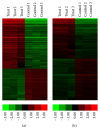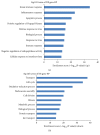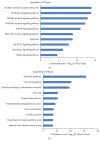Insights from lncRNAs Profiling of MIN6 Beta Cells Undergoing Inflammation
- PMID: 27698546
- PMCID: PMC5028877
- DOI: 10.1155/2016/9275106
Insights from lncRNAs Profiling of MIN6 Beta Cells Undergoing Inflammation
Abstract
Type 1 diabetes mellitus (T1DM) is an organ-specific autoimmune disease characterized by chronic and progressive apoptotic destruction of pancreatic beta cells. During the initial phases of T1DM, cytokines and other inflammatory mediators released by immune cells progressively infiltrate islet cells, induce alterations in gene expression, provoke functional impairment, and ultimately lead to apoptosis. Long noncoding RNAs (lncRNAs) are a new important class of pervasive genes that have a variety of biological functions and play key roles in many diseases. However, whether they have a function in cytokine-induced beta cell apoptosis is still uncertain. In this study, lncRNA microarray technology was used to identify the differently expressed lncRNAs and mRNAs in MIN6 cells exposed to proinflammatory cytokines. Four hundred forty-four upregulated and 279 downregulated lncRNAs were detected with a set filter fold-change ≧2.0. To elucidate the potential functions of these lncRNAs, Gene Ontology (GO) and pathway analyses were used to evaluate the potential functions of differentially expressed lncRNAs. Additionally, a lncRNA-mRNA coexpression network was constructed to predict the interactions between the most strikingly regulated lncRNAs and mRNAs. This study may be utilized as a background or reference resource for future functional studies on lncRNAs related to the diagnosis and development of new therapies for T1DM.
Figures







Similar articles
-
Aberrant expression of long noncoding RNAs in early diabetic retinopathy.Invest Ophthalmol Vis Sci. 2014 Feb 18;55(2):941-51. doi: 10.1167/iovs.13-13221. Invest Ophthalmol Vis Sci. 2014. PMID: 24436191
-
Long non-coding RNAs regulate effects of β-crystallin B2 on mouse ovary development.Mol Med Rep. 2016 Nov;14(5):4223-4231. doi: 10.3892/mmr.2016.5761. Epub 2016 Sep 22. Mol Med Rep. 2016. PMID: 27666820 Free PMC article.
-
Identification of corneal neovascularization-related long noncoding RNAs through microarray analysis.Cornea. 2015 May;34(5):580-7. doi: 10.1097/ICO.0000000000000389. Cornea. 2015. PMID: 25747163
-
The specificity of long noncoding RNA expression.Biochim Biophys Acta. 2016 Jan;1859(1):16-22. doi: 10.1016/j.bbagrm.2015.08.005. Epub 2015 Aug 19. Biochim Biophys Acta. 2016. PMID: 26297315 Review.
-
Long non-coding RNA-regulated pathways in pancreatic β cells: Their role in diabetes.Int Rev Cell Mol Biol. 2021;359:325-355. doi: 10.1016/bs.ircmb.2021.02.007. Epub 2021 Mar 2. Int Rev Cell Mol Biol. 2021. PMID: 33832652 Review.
Cited by
-
Insights from Dysregulated mRNA Expression Profile of β-Cells in Response to Proinflammatory Cytokines.J Immunol Res. 2022 Jan 22;2022:4542487. doi: 10.1155/2022/4542487. eCollection 2022. J Immunol Res. 2022. PMID: 35103245 Free PMC article.
-
LncRNA LEGLTBC Functions as a ceRNA to Antagonize the Effects of miR-34a on the Downregulation of SIRT1 in Glucolipotoxicity-Induced INS-1 Beta Cell Oxidative Stress and Apoptosis.Oxid Med Cell Longev. 2019 Oct 14;2019:4010764. doi: 10.1155/2019/4010764. eCollection 2019. Oxid Med Cell Longev. 2019. PMID: 31737170 Free PMC article.
-
LncRNA LYPLAL1-DT screening from type 2 diabetes with macrovascular complication contributes protective effects on human umbilical vein endothelial cells via regulating the miR-204-5p/SIRT1 axis.Cell Death Discov. 2022 May 4;8(1):245. doi: 10.1038/s41420-022-01019-z. Cell Death Discov. 2022. PMID: 35508613 Free PMC article.
-
LncRNAs: key players and novel insights into diabetes mellitus.Oncotarget. 2017 Aug 4;8(41):71325-71341. doi: 10.18632/oncotarget.19921. eCollection 2017 Sep 19. Oncotarget. 2017. PMID: 29050364 Free PMC article. Review.
-
Long Non-Coding RNAs in Multifactorial Diseases: Another Layer of Complexity.Noncoding RNA. 2018 May 11;4(2):13. doi: 10.3390/ncrna4020013. Noncoding RNA. 2018. PMID: 29751665 Free PMC article. Review.
References
-
- Patterson C. C., Dahlquist G. G., Gyürüs E., Green A., Soltész G. Incidence trends for childhood type 1 diabetes in Europe during 1989–2003 and predicted new cases 2005–2020: a multicentre prospective registration study. The Lancet. 2009;373(9680):2027–2033. doi: 10.1016/s0140-6736(09)60568-7. - DOI - PubMed
MeSH terms
Substances
LinkOut - more resources
Full Text Sources
Other Literature Sources

